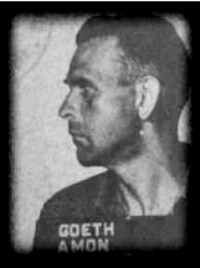 |
| Amon Göth |
Amon Göth was born on
11 December 1908 in
Vienna. He worked as
an author and was divorced with two children. Göth joined the NSDAP in
1932 (NSDAP number 510764). In
1940 he became an SS-man
(SS number 43673). His final rank was
SS-Hauptsturmführer.
Following the outbreak of WW2 Göth served in
Cieszyn, Kattowice and
Lublin.
He was
assigned to the
SS- und Polizeiführer Lublin, as part of
Aktion Reinhard. During
1942 he directed brutal clearances of small ghettos in the
Lublin district, for example during the
deportations from the
Belzyce ghetto 700 Jews were deported to the
Belzec death camp. He organised the selections
in this ghetto and around 500 people who bribed him, were selected for work in the
Budzyn labour camp, near
Krasnik.
Göth was responsible for the construction works in
Budzyn. Because of his corruption, he was in a personal conflict with
SS-Sturmbannführer Hermann Höfle, the chief staff officer
of
Aktion Reinhard. So Göth was ordered from
Lublin to
Krakow in
February 1943 where he was nominated by
SS- und Polizeiführer Scherner
to command the
Krakow-Plaszow forced labour camp. There he was promoted to
SS-Oberscharführer in
July 1943.
Mieczyslaw Pemper, who worked in the
Plaszow
camp office, testified
during Göth’s trial that he had managed to look at
Göth’s personal files and had found a letter from
SS-Gruppenführer Globocnik, commander of the
Lublin region,
addressed to the commanders of
Belzec, Sobibor and
Treblinka. The letter authorised
Göth to have access to all areas of those extermination camps, for
administration or possibly construction inspections. Under the direction of
SS-Sturmbannführer Willi Haase,
Göth conducted the final liquidation of the
Krakow ghetto, which began
on
13 March 1943. SS officers
Kunde and
Neumann also assisted with the ghetto clearance, during which mass
murders were committed. On the orders of
Haase, 75 persons
were killed in one place.
Göth’s reign of terror at
Plaszow lasted
from
February 1943 to September 1944, when he was arrested by the SS for
misappropriation of funds. Göth governed the camp in a calculatedly brutal manner. For the slightest
offence he fired at prisoners or ordered others to do, and public hangings were frequent.
Göth had two dogs called Ralf and Rolf, both trained to attack and savage
prisoners. Many people lost their lives after being attacked by these dogs.
When children were being removed from
Plaszow,
Göth ordered the camp orchestra to play nursery songs such as "Mami kauf mir ein Pferdchen" (Mum,
buy me a little horse), while their mothers were forced to stand on the parade ground and witness their
children being transported to their deaths.
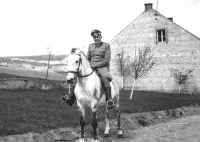 |
| Göth, Camp in the Background |
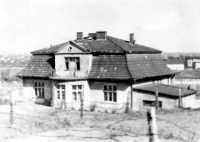 |
| Göth's House * |
Former prisoner
Henryk Bloch testified at
Göth’s trial in
1946:
"
Göth ordered his deputy to start beating us.
He went away to have his lunch. We were then taken
to the back, next to the house he lived in. Two tables were brought, also buckets of water, and they started beating
us directly on naked flesh. Göth ordered that everyone should receive
100 times each, but everyone received more than 200 and even 300. Every prisoner had to count every strike
loudly, if a mistake was made in the count by him, the beating started afresh from number one. We were not
beaten by one person, they were taking turns, as one man would tire very quickly, having to hit someone 100 times
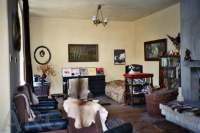 |
| Living Room, in 2004 |
with full strength. The whip would be passed to another SS man there. It was impossible, being
hit so many times, to count properly, people were making mistakes, and the beatings were starting afresh.
And so the beatings went on and on, the tables were covered in blood, as every hit meant a fresh cut in
someone’s flesh. As anyone went off the table, he was virtually one bloody mass of cut flesh.
Everyone getting off the table was ordered to report standing to attention, I report humbly that I have received my
sentence. In the course of all this, one man screamed terribly. Göth
shouted at him to calm down, to count. The man did not calm down... Göth
approached him, picked up half a brick off the ground, went to the table on which the man was being beaten,
and from a very close distance struck him on the head with the brick, splitting his head. The beating of that
man continued uninterrupted, then pouring of water and beating again. Covered in blood, with a split head,
he went off the table, approaching Göth, he reported he had received
his penalty. He was ordered to go away, and as the man turned, he pulled
out his revolver, firing into the back of the man’s head."
This man’s name was
Mr Meitlis (testimony from
Henryk Mandel).
"
When all were beaten, which took from 12 until 3 p.m., we were all taken to the police station,
and there Göth ordered doctors from the camp hospital to come to us. He did not
allow anyone to be taken to the hospital. Practically all of this group died in
Plaszow, the wounds would
not heal, the flesh was continually infected, it was rotting on us whilst we were still alive."
Following two actions in
Tarnow, 6,000 Jews were deported to
Belzec death camp in
June 1942. In
September 1942
a second resettlement action took place. During the first days of
September 1943,
Goeth was in charge of the final liquidation of the ghetto, with a force of 200 SS-men. He personally
killed dozens of people, with shots from his revolver.
Leon Leser, a mechanic, testified at Göth’s trial:
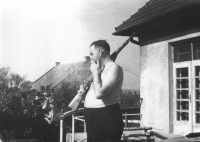 |
| Göth, at his House |
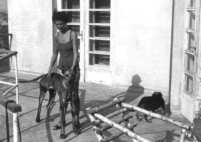 |
| Ruth Irene Kalder, "Majola" |
"
There was "Ghetto A" for those working, and "Ghetto B" for those that were unemployed.
Göth ordered everyone employed from "Ghetto A" to go to "Ghetto B",
and assemble there in groups, according to their employer. Every group had a board indicating the name of
the employer. Then Göth selected a group of 300 persons as
a Säuberungskolonne (clearing column). The Jews assembled once again separately. At that point a
fiancée of one of the Jewish men approached Göth, her name was
Batista, begging him to allow her to stay with her fiancée, who was
remaining. He refused, she begged him once again, he ordered her to turn around and fired into her head.
She fell dead, and after that he separated all the people again, he took out those that should go to
Plaszow, and those that were left behind remained on the
Magdeburger Square."
The total number killed during the clearance was 4,000, including many women and children.
Around 10,000 people were taken to
Plaszow. During the
Aktion
Göth
completely liquidated "Ghetto B". For a whole day after the
Aktion lorries collected the remains of those killed
in the streets and buildings and took them to
Plaszow for burial in a mass grave.
From
September 1943 to February 1944 Göth conducted the progressive
liquidation of the forced labour camp in
Szebnie near
Jaslo. The liquidation began on
21 September 1943
with the killing of 700 Jewish prisoners who were driven in lorries to a forest in
Tarnowiec, 3 km from the
camp, where they were shot. This "action" was carried out by
SS-Haupscharführer
Grzymek and supervised by the commander
Kellermann, acting on orders from Göth.
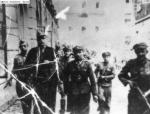 |
Göth on his Way
to the Courthouse * |
During these ghetto liquidations Göth took every opportunity to enrich
himself with furniture, furs, clothing, jewellery, tobacco and alcohol. The
Gestapo found the stored goods
in
Brünnlitz (Czechoslovakia), together with
Göth's mistress
Ruth Irene Kalder ("
Majola").
Göth was accused of larceny of Jewish property (which of course was
regarded as property of the German
Reich), and arrested on
13 September 1944.
That was the end of his career.
After the war he was extradited to Poland at the request of the Polish authorities and
tried
before the Polish Supreme Court on charges of committing mass murder during the liquidations of the ghettos at
Tarnow and
Krakow, the camp at
Szebnie and the
Plaszow camp. He was
sentenced to death in
Krakow on
5 September 1946
and hung there on
13 September 1946, defiantly saluting to
Hitler. Göth's body was cremated and his ashes scattered into the river.
Photos:
Robin O'Neil Collection
GFH
*
Sources:
The trial of Goeth - From the Robin O’Neil Collection
The Encyclopaedia of The Holocaust
The Final Solution - G. Reitlinger
© ARC 2005













